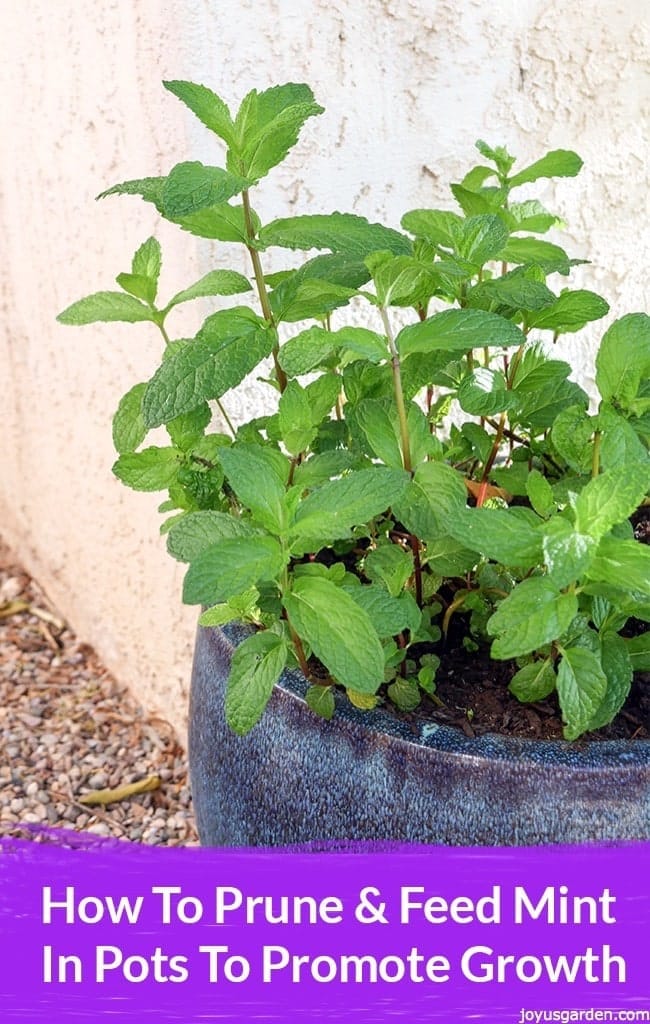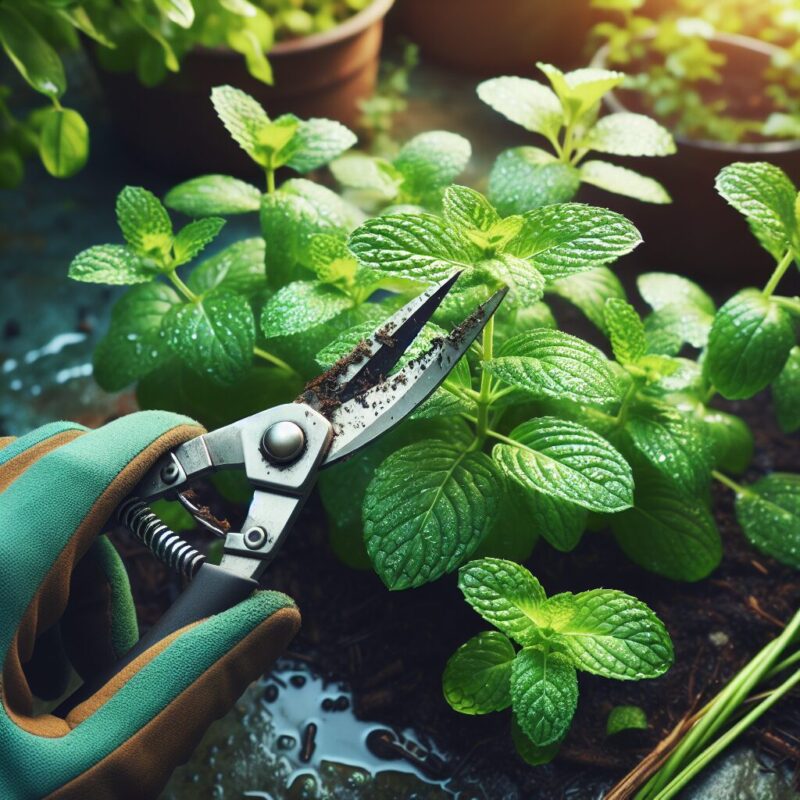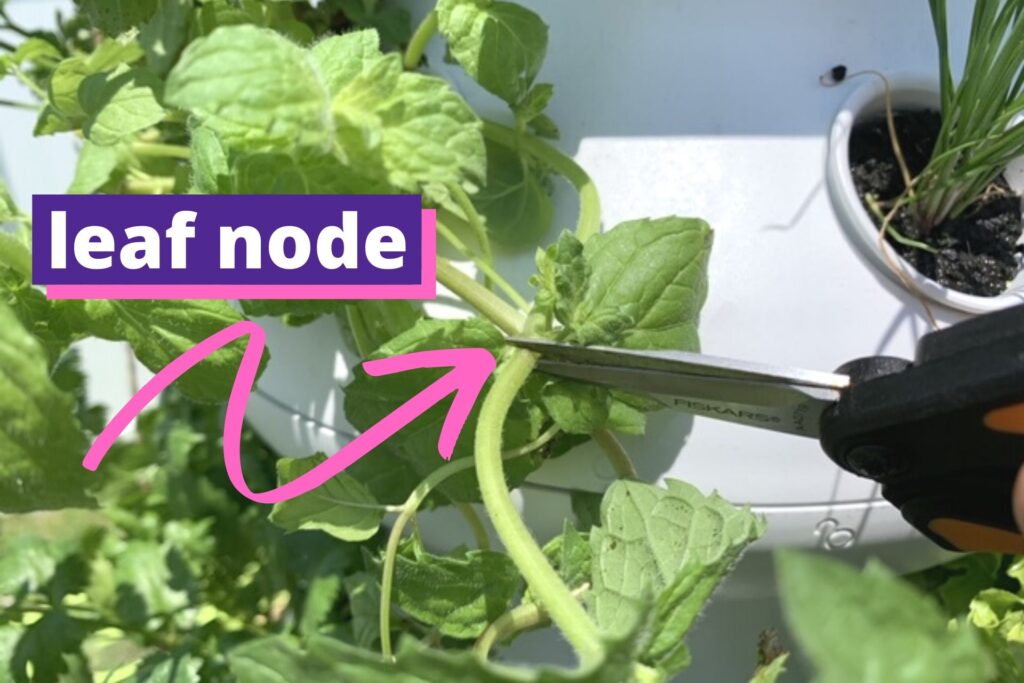Why Prune Your Mint Plant Regularly
Pruning is an essential part of mint plant care, and regular pruning can have a significant impact on the health and productivity of the plant. By pruning your mint plant regularly, you can promote healthy growth, prevent overcrowding, and encourage new leaf production. This, in turn, can lead to a more bountiful harvest and a longer lifespan for the plant.
One of the primary benefits of pruning is that it allows the plant to focus its energy on producing new growth, rather than expending energy on maintaining old or damaged leaves. This can lead to a more robust and vibrant plant, with a greater yield of fresh mint leaves. Additionally, pruning can help to prevent the plant from becoming leggy or sprawling, which can make it more difficult to harvest.
Regular pruning can also help to prevent pests and diseases from taking hold in the plant. By removing damaged or diseased leaves, you can prevent the spread of disease and reduce the risk of pest infestations. This can be especially important for mint plants, which can be susceptible to pests like spider mites and aphids.
So, how often should you prune your mint plant? The frequency of pruning will depend on the specific needs of the plant, but as a general rule, it’s a good idea to prune your mint plant every 1-2 weeks during the growing season. This will help to keep the plant healthy and promote new growth, and will also give you a steady supply of fresh mint leaves to use in cooking and other applications.
By incorporating regular pruning into your mint plant care routine, you can enjoy a healthier, more productive plant, and a more bountiful harvest of fresh mint leaves. Whether you’re using your mint leaves in cooking, teas, or potpourri, regular pruning can help to ensure that you have a steady supply of this versatile and delicious herb.
Choosing the Right Time to Cut Mint Leaves
When it comes to harvesting fresh mint leaves, timing is everything. Cutting mint leaves at the right time can make all the difference in the flavor, aroma, and overall quality of the leaves. So, when is the best time to cut mint leaves from your plant?
The optimal time to harvest mint leaves depends on the time of day, season, and growth stage of the plant. In general, it’s best to harvest mint leaves in the morning, after the dew has dried but before the heat of the day. This is when the leaves are at their most fragrant and flavorful.
In terms of season, mint plants typically thrive in the spring and summer months. During this time, the plants are actively growing and producing new leaves. It’s best to harvest mint leaves during this period, as the leaves will be at their most tender and flavorful.
When it comes to the growth stage of the plant, it’s best to harvest mint leaves when they are young and tender. Avoid harvesting leaves that are old or damaged, as they can be bitter and less flavorful. Instead, look for leaves that are bright green and have a delicate texture.
To check for readiness, simply inspect the leaves and stems of the plant. Look for leaves that are a deep green color and have a slightly wrinkled texture. Avoid leaves that are yellow or brown, as they may be past their prime. You can also perform a simple “pinch test” to check for readiness. Simply pinch the leaf between your thumb and index finger. If it comes off easily, it’s ready to harvest.
By harvesting mint leaves at the right time, you can enjoy the best flavor and aroma possible. Whether you’re using your mint leaves in cooking, teas, or potpourri, timing is everything. So, be sure to choose the right time to cut mint leaves from your plant, and enjoy the many benefits of this versatile and delicious herb.
Preparing Your Tools and Equipment
Before you start cutting mint leaves, it’s essential to prepare your tools and equipment. Having the right tools can make a big difference in the quality of your harvest and the health of your plant. Here are some of the necessary tools and equipment you’ll need to cut mint leaves:
Scissors: A good pair of scissors is essential for cutting mint leaves. Look for scissors that are sharp and have a clean, rust-free blade. You can also use pruning shears, but scissors are generally better for cutting individual leaves.
Pruning shears: Pruning shears are useful for cutting back larger stems or pruning the plant to maintain its shape. Look for shears that are sharp and have a comfortable grip.
Gloves: Wearing gloves can protect your hands from the oils in the mint leaves, which can cause skin irritation in some people. Look for gloves that are waterproof and have a good grip.
Container: You’ll need a container to collect your harvested mint leaves. Look for a container that is clean, dry, and has good airflow. You can use a basket, a bag, or a container specifically designed for harvesting herbs.
Cleanliness and sanitation are crucial when cutting mint leaves. Make sure your tools and equipment are clean and sanitized before use. You can sanitize your tools by washing them in soap and water, and then drying them with a clean towel.
It’s also essential to clean and sanitize your container before use. This will help prevent the spread of disease and pests. You can clean your container with soap and water, and then dry it with a clean towel.
By preparing your tools and equipment, you can ensure a successful harvest and maintain the health of your mint plant. Remember to always clean and sanitize your tools and equipment before use, and to handle your mint leaves with care to avoid damaging them.
The Art of Cutting Mint Leaves: Techniques and Tips
Cutting mint leaves can be a delicate process, but with the right techniques and tips, you can ensure a successful harvest. Here’s a step-by-step guide on how to cut mint leaves:
Step 1: Identify the Best Leaves to Harvest
When cutting mint leaves, it’s essential to identify the best leaves to harvest. Look for leaves that are bright green, tender, and free of damage. Avoid leaves that are yellow, brown, or wilted, as they may be past their prime.
Step 2: Cut at the Right Angle
When cutting mint leaves, it’s crucial to cut at the right angle. Cut the leaves at a 45-degree angle, just above a node (where a leaf meets the stem). This will help the plant to heal quickly and reduce the risk of disease.
Step 3: Cut in the Right Direction
When cutting mint leaves, it’s essential to cut in the right direction. Cut the leaves in a downward direction, following the natural curve of the stem. This will help to prevent the leaves from tearing and reduce the risk of damage to the plant.
Step 4: Avoid Damaging the Plant
When cutting mint leaves, it’s crucial to avoid damaging the plant. Avoid cutting too close to the node, as this can cause damage to the stem and reduce the plant’s ability to produce new leaves. Also, avoid cutting too many leaves at once, as this can cause stress to the plant.
By following these steps and techniques, you can ensure a successful harvest of fresh mint leaves. Remember to always handle the leaves with care, and to avoid damaging the plant. With a little practice, you’ll be able to cut mint leaves like a pro!
How to Cut Mint Leaves from Plant: Tips and Tricks
Here are some additional tips and tricks to help you cut mint leaves from your plant:
Use a sharp tool: A sharp tool will help to prevent the leaves from tearing and reduce the risk of damage to the plant.
Make clean cuts: Make clean cuts just above a node, and avoid crushing or tearing the leaves.
Harvest in the morning: Harvesting mint leaves in the morning, after the dew has dried, will help to ensure the best flavor and aroma.
Avoid over-harvesting: Avoid over-harvesting, as this can cause stress to the plant and reduce its ability to produce new leaves.
How to Harvest Mint Leaves for Different Uses
Mint leaves can be used in a variety of ways, from cooking and teas to potpourri and crafts. When harvesting mint leaves for different uses, it’s essential to consider the specific requirements of each use. Here are some tips on how to harvest mint leaves for different purposes:
Cooking: When harvesting mint leaves for cooking, look for leaves that are bright green and have a strong, peppery flavor. Cut the leaves just above a node, and use them immediately in your recipe. You can also dry or freeze mint leaves for later use in cooking.
Teas: When harvesting mint leaves for teas, look for leaves that are young and tender. Cut the leaves just above a node, and dry them immediately to preserve their flavor and aroma. You can also use fresh mint leaves in teas, but be sure to use them within a day or two of harvesting.
Potpourri: When harvesting mint leaves for potpourri, look for leaves that are dry and fragrant. Cut the leaves just above a node, and dry them immediately to preserve their flavor and aroma. You can also use fresh mint leaves in potpourri, but be sure to use them within a day or two of harvesting.
Crafts: When harvesting mint leaves for crafts, look for leaves that are young and tender. Cut the leaves just above a node, and use them immediately in your craft project. You can also dry or press mint leaves for later use in crafts.
Drying and Preserving Mint Leaves: To dry mint leaves, tie them in small bunches and hang them upside down in a warm, dry place. You can also dry mint leaves in a dehydrator or by spreading them out in a single layer on a paper towel. To preserve mint leaves, you can freeze them in airtight containers or bags, or store them in a cool, dry place.
By following these tips, you can harvest mint leaves for a variety of uses and enjoy their fresh flavor and aroma all year round. Whether you’re using mint leaves in cooking, teas, potpourri, or crafts, be sure to harvest them at the right time and use them immediately for the best results.
Common Mistakes to Avoid When Cutting Mint Leaves
When cutting mint leaves, it’s essential to avoid common mistakes that can damage the plant or reduce the quality of the leaves. Here are some common mistakes to avoid when cutting mint leaves:
Over-pruning: Over-pruning can cause stress to the plant and reduce its ability to produce new leaves. Avoid cutting too many leaves at once, and make sure to leave enough leaves on the plant to allow it to continue growing.
Cutting too close to the node: Cutting too close to the node can cause damage to the stem and reduce the plant’s ability to produce new leaves. Make sure to cut just above a node, and avoid cutting too close to the stem.
Not disinfecting tools: Not disinfecting tools can cause the spread of disease and pests. Make sure to disinfect your tools before and after use, and avoid sharing tools between plants.
Harvesting at the wrong time: Harvesting mint leaves at the wrong time can reduce their quality and flavor. Avoid harvesting mint leaves during the hottest part of the day, and make sure to harvest them when they are young and tender.
Not handling leaves with care: Not handling leaves with care can cause them to become damaged or bruised. Make sure to handle mint leaves gently, and avoid touching them excessively.
By avoiding these common mistakes, you can ensure a successful harvest of fresh mint leaves and maintain the health of your mint plant. Remember to always handle mint leaves with care, and to harvest them at the right time for the best flavor and aroma.
How to Cut Mint Leaves from Plant: Tips and Tricks
Here are some additional tips and tricks to help you cut mint leaves from your plant:
Use a sharp tool: A sharp tool will help to prevent the leaves from tearing and reduce the risk of damage to the plant.
Make clean cuts: Make clean cuts just above a node, and avoid crushing or tearing the leaves.
Harvest in the morning: Harvesting mint leaves in the morning, after the dew has dried, will help to ensure the best flavor and aroma.
Avoid over-harvesting: Avoid over-harvesting, as this can cause stress to the plant and reduce its ability to produce new leaves.
Post-Harvest Care: How to Keep Your Mint Plant Thriving
After harvesting your mint leaves, it’s essential to provide your plant with the right care to ensure it continues to thrive. Here are some tips on how to care for your mint plant after harvesting:
Watering: Mint plants require consistent moisture, especially after harvesting. Make sure to water your plant regularly, but avoid overwatering, which can lead to root rot and other problems.
Fertilizing: Mint plants benefit from regular fertilization, especially after harvesting. Use a balanced fertilizer that is high in nitrogen, phosphorus, and potassium to promote healthy growth and leaf production.
Providing Adequate Sunlight: Mint plants require partial shade to full sun, depending on the variety. Make sure to provide your plant with the right amount of sunlight to promote healthy growth and leaf production.
Pruning: After harvesting, it’s essential to prune your mint plant to encourage new growth and prevent it from becoming leggy. Cut back the stems to about half their height, and remove any dead or damaged leaves.
Pest and Disease Control: Mint plants are susceptible to pests and diseases, especially after harvesting. Keep an eye out for signs of pests or diseases, and take action immediately if you notice any problems.
By following these tips, you can keep your mint plant thriving after harvesting and ensure a continuous supply of fresh mint leaves. Remember to always handle your mint plant with care, and to provide it with the right conditions to promote healthy growth and leaf production.
How to Cut Mint Leaves from Plant: Tips and Tricks
Here are some additional tips and tricks to help you care for your mint plant after harvesting:
Monitor the temperature: Mint plants prefer temperatures between 60-70°F (15-21°C). Avoid placing your plant in areas with extreme temperatures.
Humidity: Mint plants prefer high humidity, but can adapt to average humidity levels. Avoid placing your plant in areas with low humidity.
Avoid over-handling: Mint plants can be sensitive to handling, so avoid touching or handling the leaves excessively.
Provide air circulation: Mint plants prefer good air circulation to prevent fungal diseases. Make sure to provide your plant with enough space and air circulation.
Troubleshooting Common Issues with Mint Leaf Harvesting
When harvesting mint leaves, you may encounter some common issues that can affect the quality and quantity of your harvest. Here are some solutions to common problems that may arise when harvesting mint leaves:
Pests: Mint plants can be susceptible to pests like aphids, whiteflies, and spider mites. To control pests, use neem oil or insecticidal soap, and make sure to inspect your plants regularly.
Diseases: Mint plants can be prone to diseases like powdery mildew, leaf spot, and root rot. To prevent diseases, make sure to provide your plants with good air circulation, water them properly, and avoid over-fertilizing.
Nutrient deficiencies: Mint plants require a balanced diet of nutrients to thrive. To prevent nutrient deficiencies, use a balanced fertilizer that is high in nitrogen, phosphorus, and potassium.
Leaf yellowing: Leaf yellowing can be caused by a lack of nutrients, too much water, or too little light. To prevent leaf yellowing, make sure to provide your plants with the right amount of nutrients, water, and light.
Leaf curling: Leaf curling can be caused by a lack of water, too much heat, or too little light. To prevent leaf curling, make sure to provide your plants with the right amount of water, heat, and light.
By following these tips, you can troubleshoot common issues that may arise when harvesting mint leaves and ensure a healthy and productive harvest. Remember to always monitor your plants regularly and take action immediately if you notice any problems.
How to Cut Mint Leaves from Plant: Tips and Tricks
Here are some additional tips and tricks to help you troubleshoot common issues with mint leaf harvesting:
Monitor the weather: Mint plants can be sensitive to extreme weather conditions. Make sure to monitor the weather and take action immediately if you notice any problems.
Use a soil test kit: A soil test kit can help you determine the nutrient levels in your soil and make adjustments accordingly.
Keep a gardening journal: Keeping a gardening journal can help you track your progress and identify any patterns or problems that may arise.
Seek advice from a gardening expert: If you’re unsure about how to troubleshoot a common issue with mint leaf harvesting, seek advice from a gardening expert.








